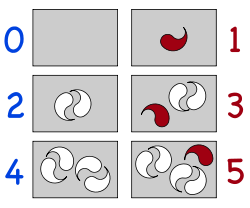0的奇偶性
一个数学问题 来自维基百科,自由的百科全书
0是一個偶數。按照定義,若某數是2的整數倍數,那麼它就是偶數,而0=0×2,所以0為偶數。[1]
此條目需要擴充。 (2017年7月13日) |

0還滿足其它一些由偶數構建出來的一些模型,例如在算術運算中的一些奇偶規則:偶數-偶數=偶數。
數學背景
一千多年以來,數學家一直難以解決數字零,非數學家仍不確定如何將其分類。巴比倫人和古希臘人使用它來區分大小,例如:26 和 206。在此之前,人們只能根據上下文的使用,來判斷一個數字是否大於另一個數字。13世紀,意大利數學家斐波那契(Fibonacci)是第一個在歐洲普及阿拉伯數字的人。他將數字一到九分類為數字,而將零分類為符號。[2]
根據劍橋大學千年數學項目詹姆斯·格萊姆博士的說法:「1990年代的反應時間實驗表明,人們在決定零是奇數還是偶數時要慢10%。」孩子們發現很難識別零是奇數還是偶數,「1990年代對小學生的一項調查顯示,約50%認為零是偶數,約20%認為零是奇數,其餘30%認為兩者都不是」格萊姆表示:「直到1600年,持續辯論和抗爭之後,零才真正被接受為偶數。」[2]
數論中眾多結論援引了算術基本定理和偶數的代數性質,因此上述選擇具有深遠的影響。例如,正數有唯一的整數分解這一事實,意味着我們可以確定一個數有偶數個不同的質因數還是奇數個不同的質因數。因為1不是素數,也沒有素數因子,是空積;因為0是偶數,所以1有偶數個不同的質因數。這意味着默比烏斯函數的值μ(1) = 1,這對於積性函數和默比烏斯反演公式是很有必要的。[5]
為什麼0是偶數
《大英百科全書》記載為:「大多數人都對數字0感到困惑,不確定它是否作為整數的起始,並且不知道其作為數字的位置。從技術上講,它表示空集。」奇偶性(Parity)[6]是先期數學課程中最早學習的規則[3],將所有整數分成兩類的方式:偶數和奇數[7]。偶數的最基礎的定義就可以直接用來證明0是偶數。偶數的定義是:如果一個數是2的整數倍數,那麼這個數便是偶數。例如:因為10=5×2,所以10是偶數。同樣的,因為0=0×2,所以0是偶數。[1]除了使用偶數的定義這樣一種證明方式來證明0是一個偶數以外,還有其它的方法來證明0是一個偶數。[8]

數字是用來計數的,人們用一個數字來表示集合內元素的個數。0則對應這沒有元素,即空集中元素的個數。對數分奇偶就是為了將集合中的元素分為兩部分。如果一個集合中的元素可兩兩配對且沒有剩餘,那麼這個集合的基數便是偶數。如果有一個元素剩餘,那麼這個集合的基數便是奇數。在此定義之下,因為空集可以被分為兩份並且沒有元素剩餘,所以0是一個偶數。[10]
還有一種更為具象的偶數定義:如果一個集合中元素可以分成基數相同的兩個集合,那麼這個集合的基數為偶數,否則為奇數。這個定義與上一個定義是等價的。在此定義之下,因為空集可以分成2個基數都為0的集合,所以0是偶數。[11]
數字可以用數軸來可視化表現,其中有個常見的特徵奇數和偶數相互交替。當負數也算入其中時,這個特徵變得尤為明顯。

一個偶數之後的第二位數字是偶數,沒有任何理由跳過0。[12]
上述的定義使用了一些數學術語,例如偶數可以被2整除,這一定義歸根到底是一個約定。和偶數不同,一些數學術語有目的的排除一些平凡或退化的情況。素數是一個非常有名的例子。在20世紀之前,素數的定義是不一致的,包括克里斯蒂安·哥德巴赫、約翰·海因里希·蘭伯特、阿德里安-馬里·勒讓德、阿瑟·凱萊在內的一些非常著名的數學家都曾經在著作中寫過0是一個素數。[13]現在對素數的定義是:如果一個數有且只有1和本身兩個約數,那麼這個數是素數。因為1只有一個約數,所以1不是一個素數。這個定義因為更加適用於很多有關素數的數學理論而被廣泛接受。例如,當1不再被認為是一個素數時,算術基本定理的表述才更加簡單,容易。[14]
既然素數可以並不包括1,那麼偶數似乎也可以並不包括0。但是在這種情況下,一些和偶數有關的數學理論變得難以表述,甚至和奇偶數有關的四則運算都要受到影響。例如,奇偶數運算中存在着以下規則:
- 偶數±偶數=偶數
- 奇數±奇數=偶數
- 偶數×整數=偶數
在這些式子的左側填入適當的數字可以使得右邊為0:
- 2-2=0
- -3+3=0
- 4×0=0
顯而易見地是,這些規則將會因為0不是一個偶數而變得不正確。[15]不過,一些堅持0不是偶數的人並不會因此改變自己的觀點,他們會加上一些特例來保證運算規則的正確性。例如,一個考試指南規定:0既不是偶數也不是奇數。[16]這樣,上述有關奇偶數的運算規則就必須加上一些例外:
- 偶數±偶數=偶數(或0)
- 奇數±奇數=偶數(或0)
- 偶數×整數=偶數(或0)
將0排除在偶數之外使得很多有關偶數的規則、定理都要加上類似的例外。
參考
相關書籍
外部連結
Wikiwand - on
Seamless Wikipedia browsing. On steroids.
